This article was published in Scientific American’s former blog network and reflects the views of the author, not necessarily those of Scientific American
I hope that one of the reasons that regular readers come here (as in, to Tet Zoo) is the coverage I give (or aim to give, constraints being what they are) weird, obscure animals. Among the weird and obscure – and we’re going to be talking about megafauna here, where nothing is really that obscure in the grand scheme of things – are the components of South America’s Cenozoic tetrapod fauna. Mostly isolated for much of the Cenozoic, South America was home to a remarkable, endemic assemblage of big, herbivorous placental mammals, marsupial-like predators and omnivores, predatory flightless birds, diverse crocodyliforms and more.
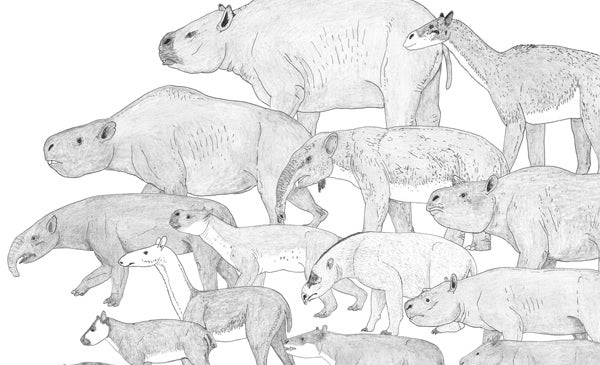
A reasonable number of notoungulates, litopterns and other extinct South American mammals have been illustrated for my in-prep textbook: you can see them all at my patreon. Credit: Darren Naish
Where do you go if you want to learn about these amazing animals? They’re all mentioned in passing in the several volumes on the extinct animals of the Cenozoic, plus there is of course a substantial technical literature. But when it comes to good, popular-level volumes that treat the subject in appropriate depth, the best has long been George Simpson’s Splendid Isolation… and it was published in 1980 (Simpson 1980). That makes it ancient, or so my kids tell me.
On supporting science journalism
If you're enjoying this article, consider supporting our award-winning journalism by subscribing. By purchasing a subscription you are helping to ensure the future of impactful stories about the discoveries and ideas shaping our world today.
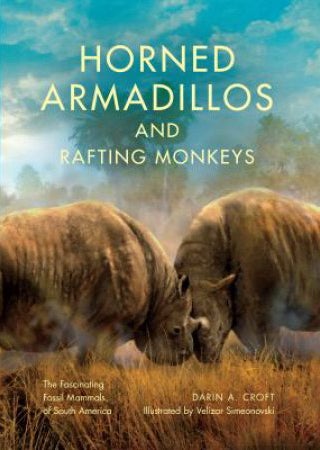
Cover of Croft (2016). Credit: Indiana University Press
Recent months have seen the publication of a significant new volume on the same subject (I previously mentioned it here in November 2016), and yet again it’s part of the Indiana University Press Life of the Past series. It’s Horned Armadillos and Rafting Monkeys, authored by Darin Croft and fantastically illustrated by Velizar Simeonovski. At a sturdy 304 pages, Horned Armadillos is of a satisfying size and I was excited to hear of its existence. In case it’s not obvious, the title refers to select details of the South American mammal assemblage: several of the extinct armadillos known from the continent’s fossil record famously have horns, and the monkeys we associate with South America can only have got to there by ‘rafting’ – that is, by arriving there following trans-oceanic travel on masses of floating vegetation.
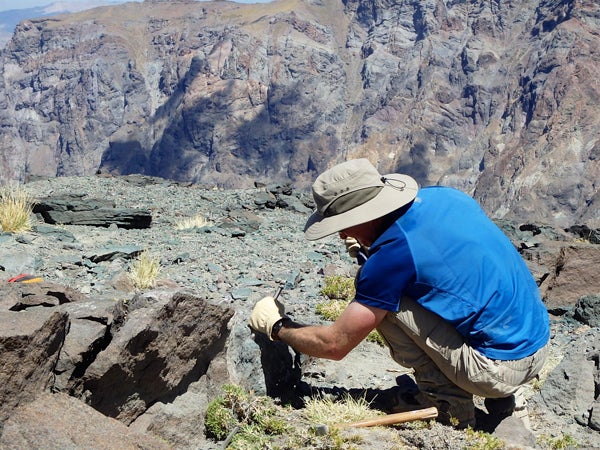
Darin Croft at work in the field, in what looks like a spectacular location. Credit: Darin Croft
Darin Croft is an established name on extinct South American mammals, his excellent and careful work mostly focusing on metatherians and notoungulates (e.g., Flynn et al. 2002, 2005, Croft 2007, Croft & Anaya 2006), and he has long had a worthy reputation as a champion of South America’s Cenozoic fossil mammals (Croft 1999). So, does this work – finally – deliver what we’ve craved for for so long? While obsessives might, of course, wish for an even longer book with even more content… YES: this is the book on extinct South American Cenozoic animals we’ve been waiting for. It does not disappoint and it does the subject proud. I cannot recommend it highly enough.
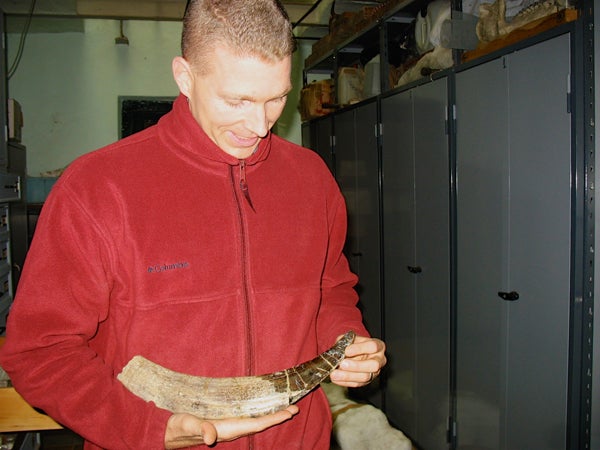
The remains of big extinct South American mammals are frequently spectacular and striking. In the image here, Darin Croft is holding the big tusk of an astrapothere. Credit: Darin Croft
Let’s begin by talking about the visual side of things. The book is gorgeous. It’s glossy, very well designed, full colour and high-resolution throughout. It’s packed with illustrations, ranging from charts and maps to locality photos, specimen photos and, of course, a large number of fantastic life reconstructions. These are produced by rising star Velizar Simeonovski and deserve special comment. After all, good reconstructions of extinct South American Cenozoic animals are (comparatively) rare. Furthermore, some of the creatures are so weird that we struggle to understand what they might have looked like in life, and some – through no coincidence – have become textbook ‘palaeoart memes’ (go here for a long article on that subject), mostly because artists (and scientists alike) have no clear idea what’s going on and simply copy that which went before.
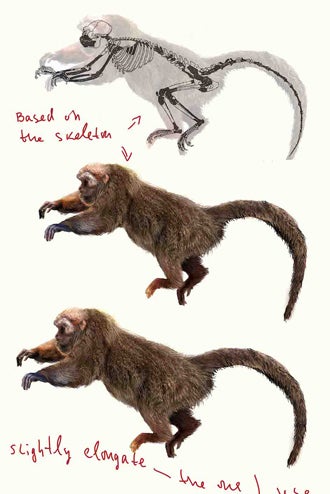
Illustrations depicting the process involved in Simeonovski’s bringing-to-life of the La Venta monkey Cebupithecia. If you’re a massive extinct mammal nerd (err..) you’ll recognise the skeleton as the one produced by Jeff Meldrum for his 1993 chapter in Daniel Gebo’s Postcranial Adaptation in Nonhuman Primates. Credit: Darin Croft and Velizar Simeonovski
Simeonovski’s images are photo-montages: really good, successful ones that blend the convincing-looking animals into the environment very well. And it’s not just Macrauchenia, Toxodon and Thylacosmilus (the staples) that are depicted: there are fantastically good depictions of the notoungulates Colbertia, Otronia, Puelia, Santiagorothia, Trachytherus, Anayatherium, Hemihegetotherium, Chasicotherium, Typotheriopsis, Trigodon and Paedotherium, the porcupine Steiromys, the sparassodonts Paraborhyaena and Acyon, the meiolaniid turtle Niolamia, a great many sloths and so, so many others. Many have not been reconstructed before. Many are shown doing really interesting things. A Glyptodon group co-operate to rescue a baby from a jaguar, a Scelidotherium mother and baby rest in their maternity burrow, the polydolopimorphian Klohnia climbs through branches in an effort to flee an impending volcanic eruption, Prolagostomus issues an alarm whistle while fleeing the predatory Lycopsis.
In creating the images, Simeonovski and Croft co-operated, the images you see here showing how they used the proportions and shapes of skeletons to ensure accuracy, there of course being a reasonable amount of extrapolation and speculation as goes details of integument and colour.
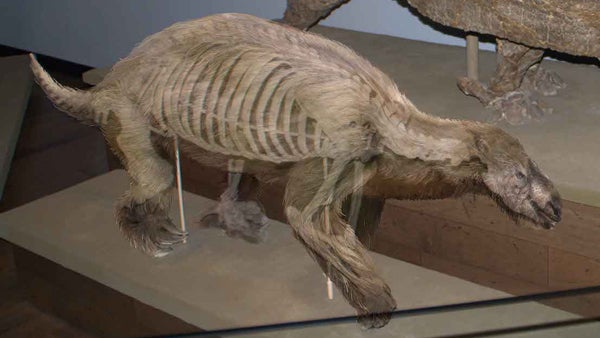
An articulated skeleton of the sloth Pronothrotherium at the Field Museum in Chicago (it’s about 1.2 m long) allowed for the creation of the life restoration you see here in translucent form. Credit: Darin Croft and Velizar Simeonovski
Naturally, some of the images work better than others: some of the animals look absolutely like real and believable animals, others are slightly less compelling. I’ve struggled to work out what it is that makes some ‘slightly less compelling’ than others; it might just be that some are weird enough that nothing can ever look right (example: Pyrotherium and the big astrapothere Granastrapotherium). Anyway, great stuff overall. Oh, and Macrauchenia is NOT ILLUSTRATED WITH A TRUNK, Croft’s accompanying text explaining how nostril location and morphology in this animal is not really suggestive of a proboscis at all. I’m relieved to hear this; I agree and have said exactly the same thing in the relevant section of the textbook I’m working on.
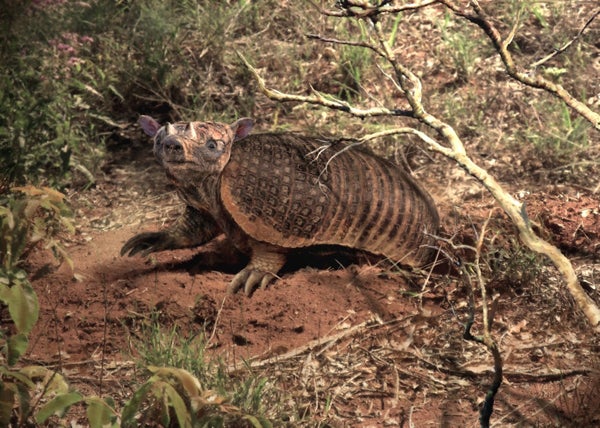
The famous horned armadillo Peltephilus from the Miocene of Chile. This animal has been the subject of various amusing mistakes. Credit: Darin Croft and Velizar Simeonovski
As goes the way the book is arranged, 17 sections take us on a ‘time tour’ of the continent, each stop discussing a specific locality. These range from Tiupampa in Bolivia where famous Lower Paleocene sediments have yielded more than 20 mammal taxa, to the Pleistocene strata of Tarija (also in Bolivia) where around 60 mammal taxa have been found.
This chronological arrangement means that we get to see the continent’s fauna evolve and become assembled over time. The small, vaguely opossum-like or rabbit-like generalists of the Paleogene are replaced by forms similar in size to tapirs, sheep and wolves, and eventually we have the spectacular, ridiculous giants of the Plio-Pleistocene: elephant-sized sloths, armadillo relatives as heavy as small cars, cats and horses from the north.
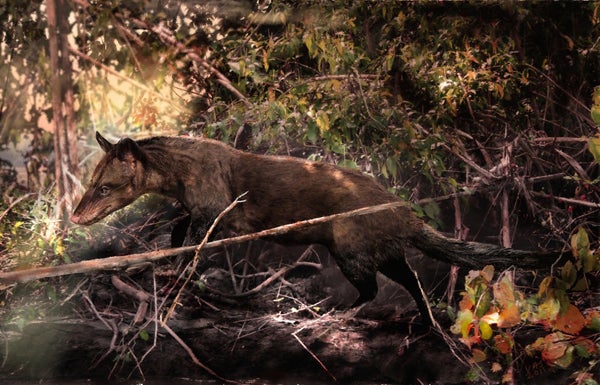
I really like the reconstructions of sparassodonts included in the book: this is wolverine-sized Acyon from the middle Miocene of Bolivia. These omnivorous or predatory metatherians might have looked something like big, long-faced opossums. Credit: Darin Croft and Velizar Simeonovski
Text on each locality covers something of the faunal composition, the conditions and environment of the time, the nature of the locality itself and often something about the history of scientific work carried out there. A select list of animals present at each locality is then discussed on a species by species basis, a block of text reviewing what we know and a ‘Basic Information’ section providing info on size, inferred ecology, evolutionary relationships and etymology. A Simeonovski life restoration and images of the relevant fossils are included too.
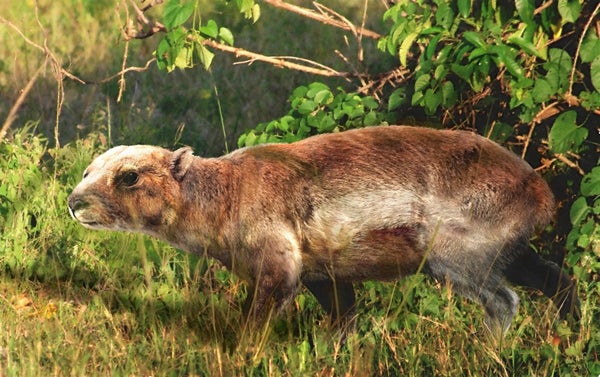
The bobcat-sized hegetotheriine notoungulate Hemihegetotherium from Miocene Bolivia, as reconstructed by Velizer Simeonovski. Credit: Darin Croft and Velizar Simeonovski
Those main blocks of text are great, combining thoughts on evolutionary history, ecology, behaviour and anatomy, and including numerous insight and much valuable and sensible commentary. If I’ve created the impression that this book is devoted only to mammals (which would be understandable given Croft’s areas of special interest), it isn’t: entries just like the mammal ones are included on a few birds (Andalgalornis and Argentavis) and on a few crocs and turtles. By far the bulk of focus is on mammals though, and you will get the fix you’ve been looking for on obscure notoungulates, litopterns, sparassodonts and so on. A dedication at the front of the book pledges it “To anyone who has ever wondered what a notoungulate looked like”. I consider myself among this select group and can only say: thank you, Darin (and Velizar), thank you indeed.
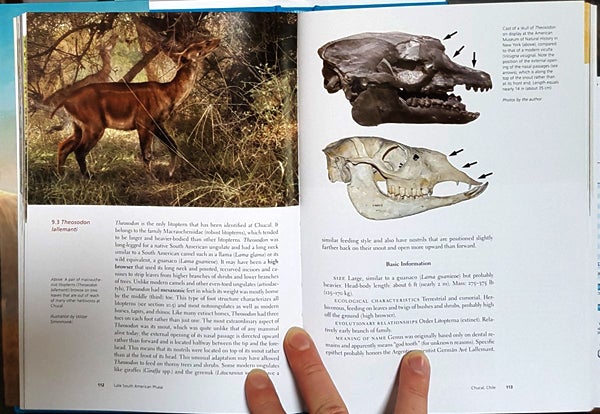
That is one sweet picture-to-text ratio :) Randomly chosen pages from Horned Armadillos. Credit: Darren Naish
Horned Armadillos and Rafting Monkeys finishes with a series of appendices that list – in full – the mammals known from the 17 localities covered in the book, and a list of references is also provided for each. All tremendously useful.
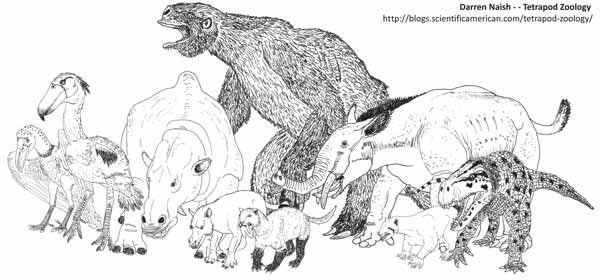
I’ve written about South America's fossil Cenozoic fauna on several occasions - here are some of the key cast members - but there’s still so much more I aim to do. Credit: Darren Naish
In short, this is a fantastically worthy, beautiful and scholarly book that will appeal to the technically minded specialist, the interested non-scientist, and to anyone in between – anyone interested in weird extinct beasts, that is. It is by far the best and most satisfying book-sized work that looks at South America’s extinct fauna so far, and it is unique in its depth of coverage and quality of content. I encourage you to get hold of a copy yourself.
Darin A. Croft. 2016. Horned Armadillos and Rafting Monkeys. The Fascinating Fossil Mammals of South America. Indiana University Press, Bloomington, Indiana, pp. 304. ISBN 978-0-253-02084-0. Here on amazon.Here on amazon.co.uk.
For previous Tet Zoo articles on South America’s Cenozoic fauna, see…
Move over Theropoda, Sebecosuchia rules (very much in need of updating/revisiting)
Stupidly large snakes, the story so far (big Cenozoic fossil snakes, but pre-Titanoboa)
Snorki the giant’s friends and relatives (more astrapotheres)
What was that skull? (introduction to glyptodonts)
Obscure fossil mammals of island South America: Thomashuxleya and the other isotemnids
Refs--
Croft, D. A. 1999. Placentals: endemic South American ungulates. In Encyclopedia of Paleontology, Fitzroy Dearborn Publishers (London), pp. 890-906.
Croft, D. A. 2007. The Middle Miocene (Laventian) Quebrada Honda fauna, southern Bolivia and a description of its notoungulates. Palaeontology 50, 277-303.
Croft, D. A. & Anaya, F. 2006. A new middle Miocene hegetotheriid (Notoungulata: Typotheria) and a phylogeny of the Hegetotheriidae. Journal of Vertebrate Paleontology 26, 387-399.
Flynn, J. J., Croft, D. A., Charrier, R., Hérial, G. & Wyss, A. R. 2002. The first Cenozoic mammal fauna from the Chilean Altiplano. Journal of Vertebrate Paleontology 22, 200-206.
Flynn, J. J. Croft, D. A., Charrier, R., Wyss, A. R., Hérail, G. & García, M. 2005. New Mesotheriidae (Mammalia, Notoungulata, Typotheria), geochronology and tectonics of the Caragua area, northernmost Chile. Journal of South American Earth Sciences 19, 55-74.